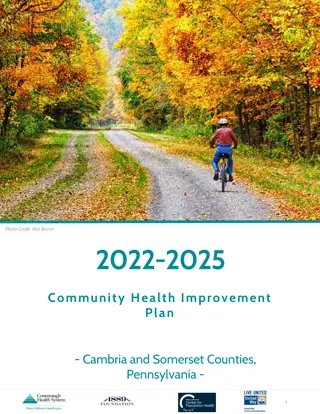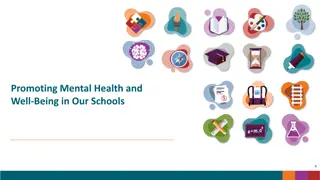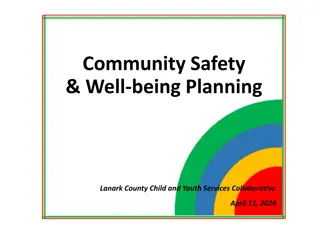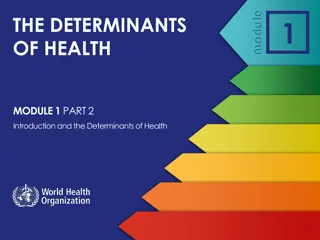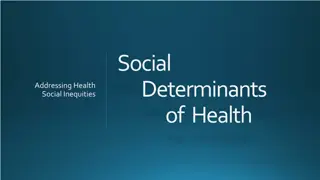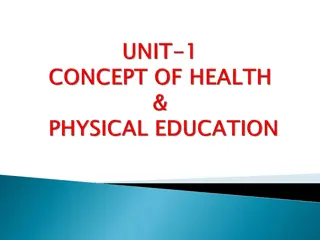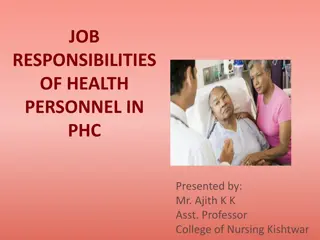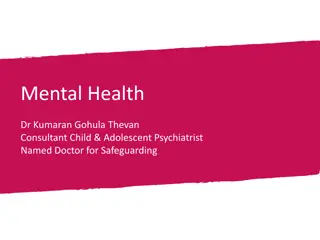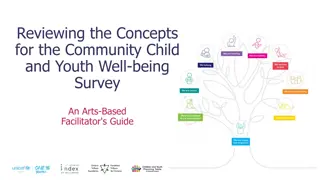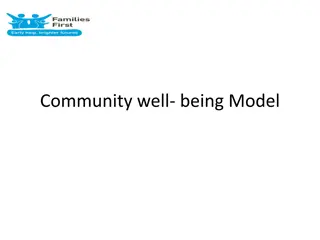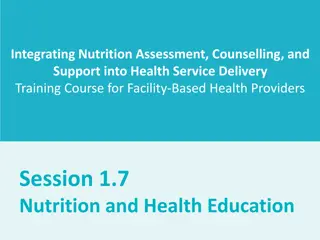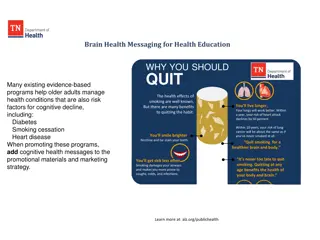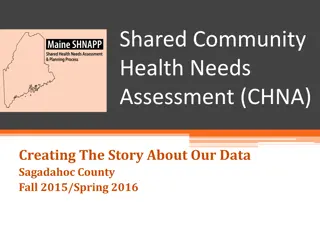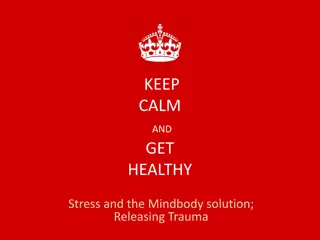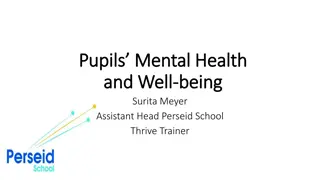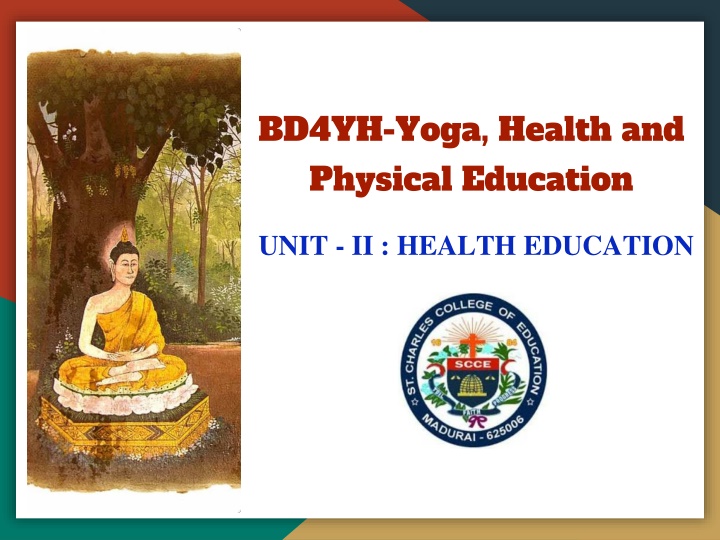
Importance of Health Education in Promoting Community Well-Being
Health education plays a vital role in improving individual and community health by imparting knowledge and shaping positive attitudes and behaviors. It aims to enhance health literacy, improve health outcomes, and elevate quality of life. Various approaches such as preventive, radical-political, and self-empowerment models are employed to address health needs effectively and achieve lasting behavior changes.
Download Presentation

Please find below an Image/Link to download the presentation.
The content on the website is provided AS IS for your information and personal use only. It may not be sold, licensed, or shared on other websites without obtaining consent from the author. If you encounter any issues during the download, it is possible that the publisher has removed the file from their server.
You are allowed to download the files provided on this website for personal or commercial use, subject to the condition that they are used lawfully. All files are the property of their respective owners.
The content on the website is provided AS IS for your information and personal use only. It may not be sold, licensed, or shared on other websites without obtaining consent from the author.
E N D
Presentation Transcript
BD4YH-Yoga, Health and Physical Education UNIT - II : HEALTH EDUCATION
Introduction to Health Education Definition: Health education is the process of imparting knowledge and developing attitudes and behaviors conducive to health. Importance: Essential for improving individual and community health. Scope: Involves various educational strategies to influence health decisions and actions. Objective: To promote health literacy, improve health outcomes, and enhance quality of life. Context: Integral part of public health systems, addressing diverse health needs.
Concept of Health Education Aim: To bring about a permanent change in individuals' competence or disposition. Impact: Influences understanding, attitudes, values, skills, and behaviors. Outcome: Results in improved personal and community health. Relevance: Integral to national health improvement efforts.
Definitions of Health Education Dr. Thomas Wood: Sum of experiences relating to individual, community, and social health. Rather Grout: Transformation of health knowledge into desirable behavior patterns through education. Focus: processes in health promotion. Emphasizes the importance of educational Application: Applies to both individual and community health contexts. Goal: Achieve lasting health behavior changes.
Approaches to Health Education Preventive Model: Encourages behaviors that prevent diseases at various levels. Radical-Political environmental change through political action. Model: Focuses on social and Self-Empowerment Model: Promotes informed choice and individual empowerment. Combination: Often used together for comprehensive health education. Adaptation: Tailored to specific community needs and contexts.
The Preventive Model Goal: To persuade individuals to adopt behaviors that prevent disease. Levels: Focuses on primary, secondary, and tertiary prevention. Behavior: Encourages responsible health decisions. Utilization: Promotes effective use of health services. Traditional: A conventional approach to health education.
The Radical-Political Model Focus: Addresses root causes of health problems. Approach: environmental change. Triggers political action for social and Goal: Achieve broader societal health improvements. Strategy: Refocuses efforts upstream to prevent health issues. Impact: Leads to significant long-term health benefits.
The Self-Empowerment Model Philosophy: promoting informed choice. Derives from the educational model Empowerment: Aims to empower individuals to make health decisions. Choice: Facilitates understanding and value clarification. Action: environment. Encourages individuals to modify their Outcome: Promotes positive health behaviors and choices.
School Health Education Context: Schools are key settings for health education. Importance: Integral to individual development and future health. Reach: Can influence a large population over time. Methods: Combines formal curriculum and supportive school environments. Role: Schools play a dual role in education and health promotion.
Goals of School Health Education Understanding: Increase knowledge about health science. Competence: Develop decision-making skills regarding personal health. Behavior: Encourage health-promoting behaviors. Skills: Teach skills to improve family and community health. Awareness: Foster awareness of the importance of health.
Objectives of School Health Schemes Promotion: Encourage positive health practices. Prevention: Prevent diseases through education and practices. Diagnosis: Ensure early diagnosis and treatment of health issues. Awareness: Raise health awareness among children. Environment: Promote a healthful school environment.
Health Facilities in Tamil Nadu Medical Colleges: 22 institutions. Hospitals: 48 attached to medical colleges. Super Specialty Hospital: 1 multi-specialty hospital. Dental College: 1 dental college and hospital. District Hospitals: 29 headquarter hospitals.
Health Facilities in Tamil Nadu (Continued) Taluk Hospitals: 274 taluk and non-taluk hospitals. PHCs: 1,747 primary health centers. Sub-Centers: 8,706 health sub-centers. Urban Centers: 476 urban primary health centers. Community Centers: 15 new community health centers.
Government Initiatives in Tamil Nadu Organ Transplantation: Cardiovascular services. Public Health: Comprehensive public health care. Medical Corporation. Services: Tamil Nadu Medical Services Maternal Health: Anemia management and maternity services. Birth Programs: Birth companion and bangle ceremonies.
Budget Allocation for Health (2017-18) Total Budget: Rs. 10,157.86 crores for health sector. Civil Works: Rs. 387.38 crores for civil infrastructure. ESI Scheme: Rs. 362.79 crores for ESI hospitals. Increment: Significant annual budget increases. Focus Areas: Infrastructure, services, and public health programs.
Infant Mortality Rate (IMR) Definition: Deaths of children under one year per 1,000 live births. Indicator: Sensitive measure of health and nutrition status. Tamil Nadu IMR: 19 per 1,000 live births (2015). Significance: Reflects overall health system effectiveness. Goals: Reduce IMR through targeted health interventions.
Maternal Mortality Ratio (MMR) Definition: Maternal deaths per 100,000 live births. Tamil Nadu MMR: 62 per 100,000 live births (2015-16). Importance: Indicator of maternal health and healthcare quality. Programs: Various maternal health initiatives in place. Outcomes: Aim to further reduce MMR.
Key Health Services in Tamil Nadu Maternity Benefits: Dr. Muthulakshmi Reddy Scheme. Mobile Health: Hospital on Wheels program. Hygiene Promotion: Menstrual hygiene initiatives. De-worming: National De-worming Day programs. Infant Care: Amma Baby Care Kits with essential items.
Health Help lines and Programs Health Helpline: 104 Health Helpline for support. Health Initiatives: Amma Arokiya Thittom program. Child Health: Rashtriya Bal Swasthya Karyakram. Adolescent Karyakram. Health: Rashtriya Kishor Swasthya Maternal programs. and Child Health: Comprehensive care
AIDS Control in Tamil Nadu AIDS Society: Tamil Nadu State AIDS Control Society (TANSACS). Goals: Zero new infections, deaths, and stigma. Achievements: Reduced prevalence rate from 1.13% (2001-02) to 0.27% (2014-15). Components: Prevention, education, care, and strategic management. Centers: Numerous ICTCs and FICTCs providing testing and counseling.
Red Ribbon Clubs (RRC) Establishment: Launched in 2005 by TANSACS. Purpose: Raise awareness and change behaviors among youth. Reach: 2,021 RRCs in educational institutions. Activities: HIV/AIDS education and life skills training. Impact: Increased youth engagement in health issues.
Life Skill Education in Schools Program Aim: Provide HIV/AIDS prevention education to 9th and 11th graders. Implementation: Conducted in 9,580 schools. Content: Focuses on life skills and health knowledge. Method: Integrated into the curriculum by trained teachers. Outcome: Empowered students with health knowledge and skills.
Scope of School Health Education Comprehensive: Covers all aspects of health and hygiene. Knowledge: Includes anatomy, disease symptoms, and causes. Practical: application. Emphasizes practical knowledge and Environment: Focuses on healthy school environments. Integration: Health education integrated into various subjects.
Components of School Health Program Healthful Living: Promotes healthy living practices. Health education. Instruction: Provides comprehensive health Health Services: Includes medical inspections and first aid. Protection: environment. Ensures a healthful and safe school Special Needs: Addresses the needs of exceptional children.
Health Education Transaction Shared Responsibility: Involves all teachers in health education. Integration: Health concepts integrated into various subjects. Primary Level: Focuses on developing health practices. Upper Primary Level: Emphasizes personal responsibility and prevention. Secondary Level: Involves exploratory projects and healthy lifestyle habits.
Recommendations for Health Education Importance: resources. Children are the future and valuable National services. Policy: Supports organized school health Holistic Approach: Includes nutrition, health, and overall development. Government Role: State administration plays a key role in implementation. Educational appropriate health materials. Materials: Development and use of
Key Areas of Health Education Personal Health: Covers individual health practices and hygiene. Nutrition: knowledge. Focuses on balanced diet and nutrition Disease Prevention: Emphasizes prevention and control of diseases. Physical Education: Encourages physical fitness and activities. Mental Health: Promotes mental well-being and stress management.
Implementing Health Education Teacher Training: Essential for effective health education. Curriculum Development: Integrates health topics into the curriculum. Community Involvement: Engages community in health promotion. Assessment: Regular evaluation of health education programs. Resources: Provision of necessary materials and facilities.
Benefits of Health Education Informed Choices: Empowers individuals to make healthy choices. Disease Reduction: Reduces incidence of preventable diseases. Improved Health: Enhances overall community health. Lifelong Impact: Promotes lifelong health and well-being. Economic Benefits: Reduces healthcare costs through prevention.
Future Directions in Health Education Innovations: Adoption of new technologies and methods. Policies: Development of supportive health policies. Collaboration: Partnerships with health organizations. Research: Ongoing research to improve health education. Global Perspective: Incorporating global health initiatives and standards.
Health Education Strategies Community Engagement: Involving community in health initiatives. Policy policies. Advocacy: Advocating for health-supportive Capacity infrastructure. Building: Strengthening health education Resource Allocation: Ensuring adequate resources for health programs. Monitoring and Evaluation: Regular assessment and improvement.
Health Promotion Techniques Campaigns: Conducting health awareness campaigns. Workshops: Organizing health workshops and seminars. Media: Utilizing media for health promotion. School Programs: Implementing health programs in schools. Collaborations: organizations. Partnering with NGOs and health
Role of Technology in Health Education E-learning: Utilizing online platforms for health education. Mobile Health: Implementing mobile health applications. Social Media: Engaging through social media campaigns. Telemedicine: Providing remote health education and consultations. Data Analytics: Using data to track and improve health outcomes.
Challenges in Health Education Funding: Limited financial resources for health programs. Access: Ensuring access to health education for all. Cultural Barriers: Overcoming cultural and societal barriers. Training: Need for continuous teacher and staff training. Sustainability: Maintaining long-term health education initiatives.
Case Studies in Health Education Success Stories: Examples of successful health education programs. Best Practices: Identifying and replicating best practices. Lessons Learned: Insights from past health education efforts. Community communities. Impact: Measuring the impact on Scalability: Potential for scaling successful programs.
Evaluation of Health Education Programs Indicators: Key indicators for program evaluation. Methods: Qualitative and quantitative evaluation methods. Feedback: Gathering feedback from participants. Improvement: programs. Using evaluation results to improve Reporting: Documenting and sharing evaluation findings.
Policy Implications of Health Education National Policies: Importance of supportive national health policies. Regulations: Ensuring regulatory frameworks for health education. Funding: Allocation initiatives. of funds for health education Advocacy: Promoting health education at policy levels. Implementation: implementation. Strategies for effective policy
Future of Health Education Trends: Emerging trends in health education. Opportunities: improvement. Opportunities for innovation and Global Impact: Role of health education in global health. Collaboration: collaborations. Importance of international Vision: advancement. Long-term vision for health education
Conclusion Investing in health education is crucial for empowering individuals to make informed decisions about their well- being. By promoting awareness, imparting practical skills, and fostering healthy behaviors, we pave the way for healthier communities and a brighter future.

